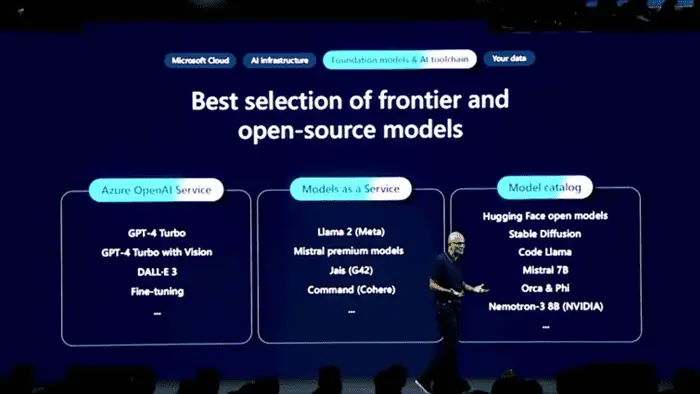How Azure leads the AI race with superior infrastructure and models, according to Microsoft CEO
2 min. read
Published on
Read our disclosure page to find out how can you help MSPoweruser sustain the editorial team Read more
Key notes
- Microsoft boasts advanced AI accelerators for cost-effective large language model training.
- From GPT-3 to PHY, Azure offers a spectrum of pre-trained models and explores groundbreaking architectures.
- Azure empowers researchers to understand and utilize data in material science and energy transition.

Satya Nadella, CEO of Microsoft, delivered a speech in India highlighting Azure’s leading position in the AI race. He outlined several key areas where Azure stands out, including:
Microsoft is heavily invested in building cutting-edge AI accelerators for training large language models. These accelerators are designed to be efficient and cost-effective, making them accessible to a wider range of developers and organizations.
“One of the things that I tell our developers at Microsoft is super ambitious today about what you can build with the best models, knowing that in 18 months, it’s going to be one-tenth, one-hundredth the cost of what it is today, and that’s a very empowering thing.”
Azure offers a comprehensive portfolio of pre-trained models, including GPT-3, GPT-4, and various open-source models. Additionally, Microsoft is actively researching and developing new model architectures like PHY and reasoning tokens, pushing the boundaries of AI capabilities.
Microsoft believes AI can be a powerful tool for scientific discovery, particularly in areas like material science and the energy transition. Azure tools are designed to help researchers understand and learn from the vast amount of data available in these fields, accelerating innovation.
The traditional data infrastructure needs an overhaul to handle the demands of AI workloads. Azure’s data solutions incorporate vector indices and embedded vector spaces, enabling efficient retrieval and analysis of large datasets.
Azure Fabric disaggregates traditional databases, offering developers more control and flexibility in storing and computing data. This allows for efficient resource allocation and cost optimization.
“I think this will have a profound impact on how we think about even the data layer in conjunction with the rest of the application.”
Nadella emphasized that Microsoft’s AI stack, encompassing infrastructure, models, data, and tools, is readily available and constantly evolving. He also highlighted the affordability of AI solutions thanks to Moore’s Law, making them more accessible.
Overall, Nadella’s speech paints a clear picture of Microsoft’s vision for the future of AI and its commitment to providing developers with the best possible tools and resources to succeed. With its focus on cutting-edge infrastructure, diverse models, data innovation, and a developer-friendly approach, Azure seems well-positioned to maintain its leadership in the AI race.
Here is the video.








User forum
0 messages